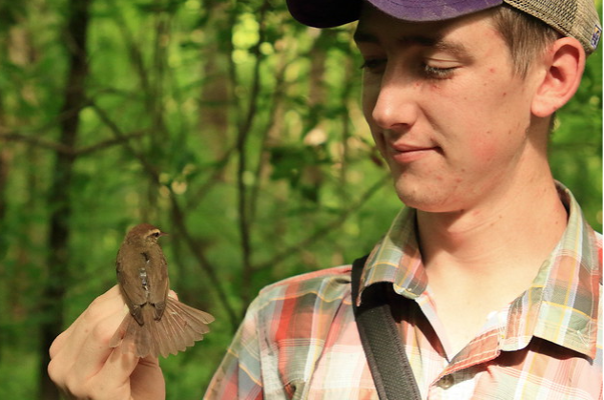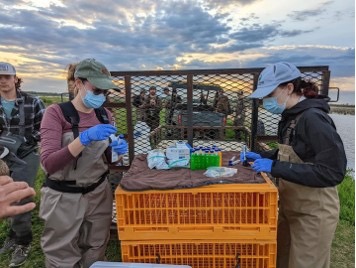Flocking Together: Bird Research Unites LSU Scientists Across Disciplines
May 01, 2024
We observe birds daily: sparrows forage at drive-through restaurants, hear their melodies in our backyards at dawn and dusk, and watch them soar through open skies over Louisiana’s endless bayous. For most, a fascination with birds ends with these kinds of observations. For others, the observations stimulate curiosity and raise questions that turn into careers, as is the case for many scientists working in various academic departments at LSU.
On Thursday, April 18, 11 of these scientists from five different departments at LSU presented their research at a “Bird Lunch” hosted by LSU Department of Biological Sciences Assistant Professors Christine Lattin and Nick Mason, who also serves as the LSU Museum of Natural Sciences (MNS) Curator of Birds, with generous support from the College of Science. Over 30 students, postdocs, and faculty members attended the lunch.

Garrett Rhyne, a graduate student in Dr. Phil Stouffer’s lab, holds a Swainson’s warbler tagged with a barometric geolocator. This new technology allows scientists to correlate the barometric pressure that a tagged bird is experiencing with global pressure maps, vastly improving location accuracy compared to previous methods. In addition to location, pressure tags advance our understanding of bird migration by documenting flight altitude, vertical airspace use, and drivers of migratory flight initiation, duration, and direction.
“I really like the idea of finding informal and inclusive ways for people to interact across units on campus,” said Mason.
Bird-centric scientific paper reading groups have existed in the past at LSU, but not since Lattin or Mason’s arrival at the university. “Bird Lunch is important because it facilitates collaborations and can help people make connections to navigate their dissertation or refine a future project,” Mason continued. “Bird Lunch is also great for new faculty and students to learn about all the ornithology taking place here that they may not yet know about.”
“I’ve wanted to do this from the time that I learned how many different scientists in different departments at LSU were doing bird research,” added Lattin. “When you are in a different department from someone, you don’t always have many opportunities to hear what they are working on, even if their research is really interesting and relevant to your own projects. That means you also miss out on potential opportunities to share expertise and collaborate.”
The research presented over the two-hour luncheon spanned five continents, including Antarctica, and at least 14 different topics, such as anatomy, physiology, and medicine; behavioral and ecological traits; bird conservation; and specialized methods and equipment each lab uses to study birds. A huge breadth of bird research is being conducted at LSU, which means that a single researcher could not be an expert in every area.
Assistant Professor Flavia Montaño, Department of Biological Sciences, shared her tropical ecology research on how bird communities change at different elevations. "Bird Lunch" attendees learned from Montaño that as elevation increases, interaction networks between bird species are more tightly connected, and that some species are “filtered out” of the networks.
Associate Professor Mike Polito, Department of Oceanography and Coastal Sciences, studies the marine ecology of coastal bird communities. Some of his recent research shared at "Bird Lunch" examines stable oxygen isotopes in preserved penguin stools to identify whether penguins are drinking snow or seawater, allowing scientists to analyze Antarctic rainfall patterns over time.
A few other fun facts learned by the attendees: there are six different ways birds can make red eyes, including the use of their own blood (Eamon Corbett, PhD candidate in the Brumfield and Faircloth labs); neotropical birds that follow army ants may find ant swarms using an acute sense of smell (Assistant Professor and LSU MNS Curator of Genetic Resources Greg Thom); and invasive Eurasian tree sparrows are picky eaters that are unwilling to try new foods while a closely-related, more successful invasive species, the house sparrow, will try unfamiliar foods (Lattin’s lab).

Allison Vestal-Laborde, a graduate student in Dr. Ashley Long’s lab, prepares for avian coronavirus sampling with the help of volunteers. This research is done in partnership with Louisiana’s Department of Wildlife and Fisheries banding efforts at Rockfeller Wildlife Refuge. These data will be used to draw connections between avian migration and disease ecology in Louisiana’s waterfowl.
Regardless of their specific topic or research locale, most of the scientists shared a similar interest other than birds: collaboration! Professor Thomas Tully Jr. from the School of Veterinary Medicine was one of the many scientists advocating for more inter-department collaborations. “We live on our islands,” he said, “and we think we have everything there, but we don’t.” That is, many of us believe we have all the resources and equipment to answer questions within each department, but we can do so much more when we connect across disciplines, departments, and colleges.
This lunch created new opportunities for LSU researchers to expand their research programs through collaboration: “I had the opportunity to talk to Professor Sabrina Taylor in the Department of Renewable Natural Resources about her work using DNA metabarcoding of bird poop to identify what birds are eating,” said Lattin, “This has been something I’ve been interested in for a while. She gave me some helpful tips!”
Mason’s research program may also benefit from resources available at LSU’s Vet School: “It was exciting to learn about the expertise and instrumentation available at the Vet School. Many of these technologies have exciting applications for studying museum specimens. For example, Samantha Rutledge, a PhD student in my lab group, is studying the micro- and nano-structures that generate iridescent coloration in starlings.”
It is clear that several new research collaborations may take flight thanks to the "Bird Lunch," and there are hopes for this event to continue each semester if funding permits. Lattin and Mason discussed expanding the audience to undergraduates and the general public interested in birds. As suggested by Mason, “We could record the bird lunches and put them on YouTube or some other platform if we don’t have the space or funding to do a Bird Lunch that is open to the public.”